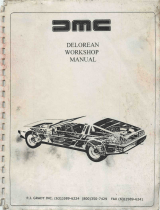
MOUNTING
BRACKET
HORIZONTAL
ADJUSTING
NUTS
ROLLER
RETAINER
ROLLER
RETAINER
SLOT
ROLLER
BRACKET
RETAINER
PIVOT BOLT
RETAINER
SLOT BOLT
ROLLER
(Site-supplied)
STUD
BLOCK
VERTICAL
ADJUSTING
NUTS (hidden)
BEFORE YOU BEGIN:
• PHYSICALLY LOCK OUT AND TAG THE
CONVEYOR AT THE POWER SOURCE.
• Select the best location, either in front or
behind the belt cleaner, to provide a at
stable belt for the cleaner.
• The stabilizing roller should be installed no
closer than 6" to 8" (150-200 mm) in front or
behind the cleaner.
• For Stabilizing Roller Bracket Kits, select a
return roller from on-site inventory and be
sure that it ts into the roller retainer slot.
The standard kit is designed for CEMA C &
D rollers.
• If welding, protect all fastener threads from
weld spatter.
TOOLS NEEDED:
• TAPE MEASURE
• ¾" (19mm) COMBINATION
WRENCH
• ½" (13mm) COMBINATION
WRENCH
• 6" SQUARE
• (2) 6" C-CLAMPS (For temporary
positioning of mounting brackets
• CUTTING TORCH AND/OR
WELDER
Stabilizing Roller Bracket Kit Instructions
for Secondary Belt Cleaners

STEP 3. Take roller measurement.
Determine the inside groove-to-groove distance on the
roller.
a. Using a tape measure, determine the length (A) of the
roller face (Fig. 3a).
b. Using a square, determine the distance (B) from the
inside of the shaft groove to the roller face (Fig. 3b).
c. Calculate the groove-to-groove measurement (C) (Fig. 3c).
A _____+ B_____ + B_____ = C_____
Fig. 1a Fig. 1b
STEP 1. Determine the location for the stabilizing roller.
In most cases it is recommended that a stabilizing roller is to be located no closer than 6" to 8"
(150–200mm) before or behind the secondary cleaner (Fig. 1a & 1b).
STEP 2. Locate the position for the
mounting brackets.
The position of the mounting brackets can
vary slightly depending on the diameter of the
return roller and the roller shaft. As a rule of
thumb: position the front of the mounting bracket
3" (75mm) past the contact point where the
stabilizing (return) roller will meet the belt (Fig. 2).
Note: the mounting brackets should always be
located so the direction of the belt is pushing the
roller into the roller retainer groove. Weld or bolt
the brackets into place on the structure.
BELT DIRECTION BELT DIRECTION
Fig. 3b B
Fig. 2
Fig. 3a
Fig. 3c
3"
(75mm)
2
A
6" to 8" Minimum
(150-200mm)
6" to 8" Minimum
(150-200mm)

STEP 4. Determine the correct location for mounting the stud blocks.
The horizontal adjustment of the brackets is dependent on the position of the stud blocks. The distance
between the mounting bracket and the roller groove-to-groove dimension C determines how the stud
blocks are mounted.
a. Measure the distance (D) between the mounting brackets (Fig. 4a).
b. Calculate dimension E. D_____ - C_____ = E______
c. If dimension E is less than 6-1/2" (163mm), position the stud blocks outward on both sides (Fig. 4b).
d. If dimension E is between 5-1/2" (138mm) and 15" (375mm), position the stud block inward (Fig. 4c).
STEP 5. Mount the roller brackets.
a. Divide dimension E by 2. This will be the measurement (F) used
to position the roller bracket to the mounting bracket (Fig. 5a).
E _____÷ 2 = F _____
b. Depending on vertical reach and adjustability needed, the
roller brackets can be installed in either of two positions
(Fig 5b). Note: Whenever possible, use the lower roller
retainer slots for the roller; this will ensure that the unit is
out of the way if the belt mistracks. Choose position 1 or 2
and bolt the roller brackets to the mounting brackets at the
F dimension (refer to Fig. 5a).
Fig. 4a Fig. 4b Fig. 4c
Fig. 5a
Fig. 5b
Position 1 Position 2
HORIZONTAL
ADJUSTING
NUTS AND
WASHERS
F
3
Stud Blocks
Outward
Stud Blocks
Inward

Fig. 7
STEP 6. Install the roller.
a. Remove the roller retainer slot bolts and loosen the pivot bolts (Fig. 6a).
b. Rotate the roller retainers to the open position and push the roller all the way into the roller
retainer slots (Fig. 6b).
c. Rotate the roller retainer to the locked position and reinstall the retainer slot bolts and tighten.
Also tighten the retainer pivot bolts (Fig. 6c).
Fig. 6a Fig. 6b Fig. 6c
RETAINER
PIVOT BOLT
RETAINER SLOT
BOLT, LOCK
WASHER AND FLAT
WASHER
Open
Position
RETAINER SLOT
BOLT, LOCK
WASHER AND FLAT
WASHER
RETAINER
PIVOT BOLT
Pressure to
Flatten Belt
Belt
Direction
VERTICAL
ADJUSTING
NUTS
STEP 7. Adjust the roller to the belt.
Loosen the vertical adjusting nuts and apply downward
pressure on the roller until the belt is at (remove
cupping or slack tension) (Fig. 7). Note: it is important
to apply equal pressure to both sides of the roller.
Retighten the vertical adjusting nuts.
2525 Wisconsin Avenue • Downers Grove, IL 60515-4200 • USA
Tel: (630) 971-0150 • Fax: (630) 971-1180 • E-mail: info@flexco.com
Visit www.flexco.com for other Flexco locations and products.
©2017 Flexible Steel Lacing Company. 02/03/17 For Reorder: X1066
/










